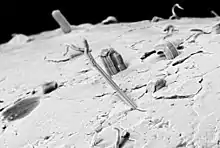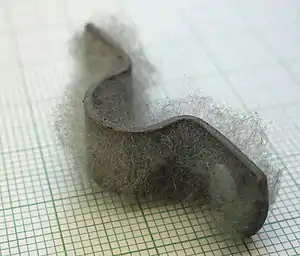Whisker (metallurgy)
Metal whiskering is a phenomenon which occurs in electrical devices when metals form long whisker-like projections over time. Tin whiskers were noticed and documented in the vacuum tube era of electronics early in the 20th century in equipment that used pure, or almost pure, tin solder in their production. It was noticed that small metal hairs or tendrils grew between metal solder pads causing short circuits. Metal whiskers form in the presence of compressive stress. Zinc, cadmium, and even lead whiskers have been documented.[1] Many techniques are used to mitigate the problem including changes to the annealing process (heating and cooling), addition of elements like copper and nickel, and the inclusion of conformal coatings.[2] Traditionally, lead has been added to slow down whisker growth in tin-based solders.

Following the Restriction of Hazardous Substances Directive (RoHS), the European Union banned the use of lead in most consumer electronic products from 2006 due to health problems associated with lead and the "high-tech trash" problem, leading to a re-focusing on the issue of whisker formation in lead-free solders.
Mechanism

Metal whiskering is a crystalline metallurgical phenomenon involving the spontaneous growth of tiny, filiform hairs from a metallic surface. The effect is primarily seen on elemental metals but also occurs with alloys.
The mechanism behind metal whisker growth is not well understood, but seems to be encouraged by compressive mechanical stresses including:
- residual stresses caused by electroplating,
- mechanically-induced stresses,
- stresses induced by diffusion of different metals,
- thermally-induced stresses, and
- strain gradients in materials.[3]
Metal whiskers differ from metallic dendrites in several respects; dendrites are fern-shaped, and grow across the surface of the metal, while metal whiskers are hair-like and project perpendicularly to the surface. Dendrite growth requires moisture capable of dissolving the metal into a solution of metal ions which are then redistributed by electromigration in the presence of an electromagnetic field. While the precise mechanism for whisker formation remains unknown, it is known that whisker formation does not require either dissolution of the metal or the presence of an electromagnetic field.
Effects

Whiskers can cause short circuits and arcing in electrical equipment. The phenomenon was discovered by telephone companies in the late 1940s and it was later found that the addition of lead to tin solder provided mitigation.[4] The European Restriction of Hazardous Substances Directive (RoHS), that took effect on July 1, 2006, restricted the use of lead in various types of electronic and electrical equipment. This has driven the use of lead-free alloys with a focus on preventing whisker formation, see § Mitigation and elimination. Others have focused on the development of oxygen-barrier coatings to prevent whisker formation.[5]
Airborne zinc whiskers have been responsible for increased system failure rates in computer server rooms.[6] Zinc whiskers grow from galvanized (electroplated) metal surfaces at a rate of up to a millimeter per year with a diameter of a few micrometres. Whiskers can form on the underside of zinc electroplated floor tiles on raised floors due to stresses applied when walking over them; these whiskers can then become airborne within the floor plenum when the tiles are disturbed, usually during maintenance. Whiskers can be small enough to pass through air filters and can settle inside equipment, resulting in short circuits and system failure.
Tin whiskers don't have to be airborne to damage equipment, as they are typically already growing in an environment where they can produce short circuits. At frequencies above 6 GHz or in fast digital circuits, tin whiskers can act like miniature antennas, affecting the circuit impedance and causing reflections. In computer disk drives they can break off and cause head crashes or bearing failures. Tin whiskers often cause failures in relays, and have been found upon examination of failed relays in nuclear power facilities.[7] Pacemakers have been recalled due to tin whiskers.[8] Research has also identified a particular failure mode for tin whiskers in vacuum (such as in space), where in high-power components a short-circuiting tin whisker is ionized into a plasma that is capable of conducting hundreds of amperes of current, massively increasing the damaging effect of the short circuit.[9] The possible increase in the use of pure tin in electronics due to the RoHS directive drove JEDEC and IPC to release a tin whisker acceptance testing standard and mitigation practices guideline intended to help manufacturers reduce the risk of tin whiskers in lead-free products.[10]
Silver whiskers often appear in conjunction with a layer of silver sulfide which forms on the surface of silver electrical contacts operating in an atmosphere rich in hydrogen sulfide and high humidity. Such atmospheres can exist in sewage treatment and paper mills.
Whiskers over 20 µm in length were observed on gold-plated surfaces and noted in a 2003 NASA internal memorandum.[11]
The effects of metal whiskering were chronicled on History Channel's program Engineering Disasters 19.
Mitigation and elimination
Several approaches are used to reduce or eliminate whisker growth with ongoing research in the area.
Conformal coatings
Conformal compound coatings stop the whiskers from penetrating a barrier and reaching a nearby termination and forming a short. These include barriers made of a ceramic or polymeric compound. Polymeric compounds tend to deflect the whisker away while ceramic chemistries prevent puncturing of the coating.[12]
Tin whisker examples and incidents
Galaxy IV
Galaxy IV was a telecommunications satellite that was disabled and lost due to short circuits caused by tin whiskers in 1998. It was initially thought that space weather contributed to the failure, but later it was discovered that a conformal coating had been misapplied, allowing whiskers formed in the pure tin plating to find their way through a missing coating area, causing a failure of the main control computer. The manufacturer, Hughes, has moved to nickel plating, rather than tin, to reduce the risk of whisker growth. The trade-off has been an increase in weight, adding 50 to 100 kilograms (110 to 220 lb) per payload.[14]
Millstone Nuclear Power Plant
On April 17, 2005, the Millstone Nuclear Power Plant in Connecticut was shut down due to a "false alarm" that indicated an unsafe pressure drop in the reactor's steam system when the steam pressure was actually nominal. The false alarm was caused by a tin whisker that short circuited the logic board that was responsible for monitoring the steam pressure lines in the power plant.[15]
Toyota accelerator position sensors false positive
In September 2011, three NASA investigators claimed that the tin whiskers they identified on the Accelerator Position Sensors[16] of sampled models of Toyota Camry could contribute to the "stuck accelerator" crashes affecting certain Toyota models during 2005–2010.[17] This contradicted an earlier 10-month joint investigation by The National Highway Traffic Safety Administration (NHTSA) and a large group of other NASA researchers that found no electronic defects.[18]
However, in 2012 NHTSA maintained: "We do not believe that tin whiskers are a plausible explanation for these incidents...[the likely cause was] pedal misapplication."[19]
Toyota also maintains that tin whiskers were not the cause of any stuck accelerator issues: "In the words of U.S. Transportation Secretary Ray LaHood, 'The verdict is in. There is no electronic-based cause for unintended high-speed acceleration in Toyotas. Period.'" According to a Toyota press release, "no data indicates that tin whiskers are more prone to occur in Toyota vehicles than any other vehicle in the marketplace." Toyota also states that "their systems are designed to reduce the risk that tin whiskers will form in the first place."[20]
See also
| Wikimedia Commons has media related to Whiskers (metal). |
References
- Lyudmyla Panashchenko. "Whisker Resistant Metal Coatings" (PDF). NEPP NASA. Retrieved 23 October 2013.
- Craig Hillman; Gregg Kittlesen & Randy Schueller. "A New (Better) Approach to Tin Whisker Mitigation" (PDF). DFR Solutions. Retrieved 23 October 2013.
- Sun, Yong; Hoffman, Elizabeth N.; Lam, Poh-Sang; Li, Xiaodong (2011). "Evaluation of local strain evolution from metallic whisker formation". Scripta Materialia. 65 (5): 388–391. doi:10.1016/j.scriptamat.2011.05.007.
- George T. Galyon. "A History of Tin Whisker Theory: 1946 to 2004" (PDF). iNEMI. Retrieved 21 December 2012.
- "Whisker Effect". INELCO. Retrieved 5 January 2011.
- "Zinc whisker induced failures in electronic systems". ERA Technology. Archived from the original on 16 January 2013. Retrieved 21 December 2012.
- "Event Notification Report for July 12, 1999". U.S. Nuclear Regulatory Commission. Retrieved 21 December 2012.
- "ITG Subject: Tin Whiskers – Problem, Causes, and Solutions". Food and Drug Administration. 1986-03-14. Archived from the original on October 18, 2007. Retrieved 21 December 2012.
- Jay Brusse; Henning Leidecker; Lyudmyla Panashchenko (December 5, 2007). "Metal Whiskers: Failure Modes and Mitigation Strategies" (PDF). NASA. Retrieved 21 December 2012.
- "JEDEC and IPC Release Tin Whisker Acceptance Testing Standard and Mitigation Practices Guideline". JEDEC.org. 4 May 2006. Retrieved 5 January 2011.
- Alexander Teverovsky (April 2003). "Introducing a New Member to the Family: Gold Whiskers" (PDF). NASA. Retrieved 21 December 2012.
- John Burke (September 2010). "Tin Whiskers Eliminated".
- Keun-Soo Kim, Suk-Sik Kim, Seong-Jun Kim, Katusaki Suganuma, ISIR, Osaka University, Masanobu Tsujimoto, Isamu Yanad, C. Uyemura & Co., Ltd., Prevention of Sn whisker formation by surface treatment of Sn plating Part II, TMS Annual Meeting, 2008
- Felps, Bruce. "'Whiskers' Caused Satellite Failure: Galaxy IV Outage Blamed On Interstellar Phenomenon". Archived from the original on March 3, 2009. Retrieved 19 October 2019.
- "Reactor Shutdown: Dominion Learns Big Lesson From A Tiny 'tin Whisker'" (PDF).
- "Treatise" (PDF). nepp.nasa.gov.
- Bunkley, Nick (27 March 2018). "Toyota Issues a 2nd Recall Over Accelerators". NYTimes.com.
- "NHTSA-NASA Study of Unintended Acceleration in Toyota Vehicles". NHTSA. Retrieved 14 November 2014.
- "NHTSA rejects 'tin whiskers' theory for Toyota's unintended acceleration incidents". Automotive News. Retrieved 14 November 2014.
- "'Tin Whiskers' and Other Discredited Unintended Acceleration Theories". Toyota. 24 January 2012. Retrieved 29 September 2019.